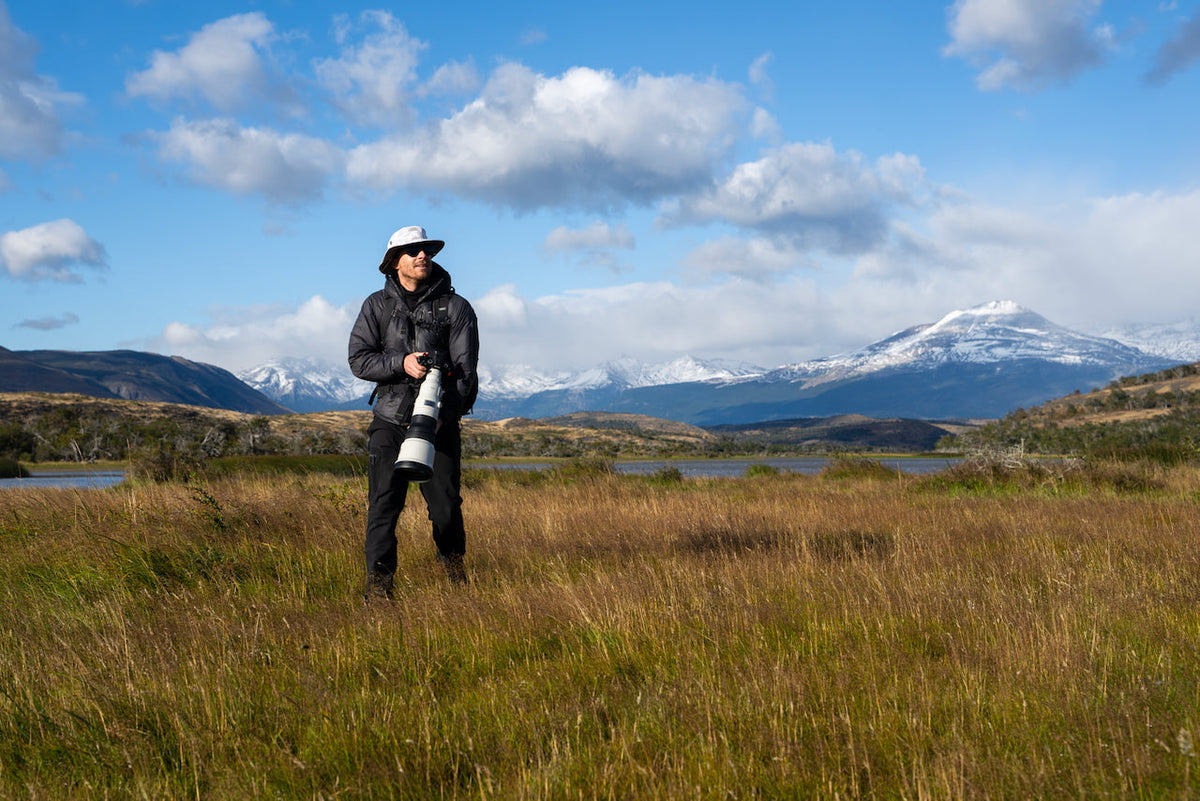

FOR IMMEDIATE RELEASE
March 21st, 2025 | Boulder, CO
In February 2025, Patagonia’s windswept steppe transformed into a classroom without walls for an exclusive wildlife photography workshop hosted by Michelle Valberg, Keith Ladzinski and myself, alongside renowned puma tracker and guide Jorge Cardenas. Set in the rugged beauty of Torres del Paine National Park, the week-long expedition brought a small group of participants face-to-face with one of South America’s most elusive predators, the puma.


In the far south of Chile, where the land fractures into wind-carved granite towers and the sky feels as raw and infinite as the Southern Ocean beyond, there’s a place where wild cats rule. Torres del Paine National Park is known for its jagged peaks, turquoise lakes and the kind of wind that can bowl you over without warning. But to the few who know where to look, it is also one of the best places on Earth to encounter Puma concolor, the elusive mountain lion of South America, not from the safety of a vehicle, but quietly, on foot.
It was late austral spring when I arrived, that restless transition between winter and summer when the guanacos have dropped their young and the pumas are most active, hunting to feed their growing cubs. The air carried a restless energy. The winds swept across the steppe in waves, rattling the lenga trees, pulling curls of cloud from the peaks of the Paine massif. In this place, the pumas are not only apex predators but also integral threads in a delicate ecological tapestry, their presence keeps the guanaco herds sharp and balanced, which in turn shapes the grasses and the smaller creatures that depend on them.
Unlike most large carnivore encounters in the modern world, seeing a puma here can be startlingly intimate. These cats are protected by the park’s strict rules and more importantly, by a deeply ingrained local respect for wildlife. Over the past decade, careful tourism management has made it possible for experienced trackers to bring photographers and filmmakers into the heart of puma country, not to harass or crowd them, but to simply witness.
Our days began long before the first light touched the snowfields. The alarm would sound in the blackness, and by the time the eastern sky hinted at blue, we were already moving — boots crunching over frost-stiff grass, breath steaming in the cold. The trackers walked ahead, eyes scanning the ground for fresh prints, for the telltale scatter of guanaco fur on the wind, for the silent signs that a cat had passed through.
The first sighting came on the second morning. She was a large female, coat the color of the surrounding hills, her body flowing over the earth in that perfect combination of power and grace that only big cats possess. She moved with purpose, stopping now and then to turn her ears toward the distance, tail twitching with concentration. We stayed downwind, kneeling in the grass, lenses trained, hearts pounding. It’s one thing to know a puma can take down an animal three times its size. It’s another to feel the ripple of muscle beneath her skin from barely thirty meters away.
Torres del Paine in spring is alive with contrasts. In the sheltered valleys, flowers push through the thawing soil, yellow calafate blossoms, violet lupines, even as snow squalls sweep in from the mountains. The light changes by the minute, turning the park into an ever-shifting palette of color and shadow. Photographing pumas here is as much about reading the land as it is about watching the animal. You learn to predict when the clouds will break, when the wind will ease for a second, when the cat might crest a hill with the massif blazing in the background.
One afternoon, we followed a young male for hours. He was lean and restless, padding through gullies and across ridges, pausing to scan for guanacos. At one point, he settled on a rise and lay watching a herd in the valley below. The wind carried the scent of dust, grass and guanaco musk. It was a scene that could have been lifted from any century, nothing modern intruded. In that moment, I understood the true privilege of this work, it’s not just about the image, but about being allowed into a fragment of the animal’s life, one that continues whether we are there or not.
Walking with pumas is an exercise in patience and humility. There are days when you cover miles with nothing but wind for company, when every valley feels empty and the cats remain phantoms. Then there are days when everything happens at once, when you round a bend and there she is, a mother with cubs, moving silently across a hillside dappled in evening light. You watch the cubs tumble over each other, mock-hunting in the grass, while she keeps one eye on them and another on the horizon.
These encounters leave an imprint. They shape how you see the world, how you value wilderness. They also become the backbone of my fine art print collections from Patagonia — images not just of the cats themselves, but of the vast landscapes they inhabit. The windswept ridges, the glacial lakes that shift from jade to cobalt with the light, the granite spires that pierce the clouds. Each photograph is more than a portrait, it is a chapter in a larger story of survival, adaptation and beauty.
Torres del Paine is changing. Tourism is growing and with it comes both opportunity and risk. The local guides and trackers understand this better than anyone. Many of them are former gauchos who have traded horses for spotting scopes, channeling their deep knowledge of the land into conservation-minded tourism. Every visitor who comes here to see a puma, leaves with a better understanding of its role and becomes part of a wider effort to protect this place.
As a photographer, my responsibility is to ensure the work gives back, by raising awareness, by supporting local guides and by creating prints that inspire people to care about the wild places they depict. Some of these Patagonia prints now hang in homes and offices far from the southern tip of the Americas, but I hope they carry with them the feeling of that wind, that light, that moment when the cat turned and met my gaze.
In the end, walking with pumas in Patagonia is not about the adrenaline of the encounter. It’s about slowing down to the rhythm of the land, about learning to see what’s hidden, about recognizing that in a world of constant noise, there are still places where the wild is whole and where, if you move carefully enough, it will let you walk beside it.


“In a place like Patagonia, nature sets the schedule,” Joyce reflected. “The challenge—and reward—is adapting your creative process to the rhythms of the land and the wildlife.”


Afternoons offered time for editing, image reviews and in-depth discussions on conservation-driven storytelling. Participants left with more than just portfolio-worthy images, they left with a renewed understanding of the ethical and creative responsibilities that come with photographing wildlife.
Given the success of the 2025 program, I hope to return in 2026, with an expanded curriculum and more opportunities to engage with the park’s extraordinary biodiversity.




The Pull of the Paine
High alpine photography resonates because it is elemental. It speaks to endurance, to resilience, to beauty stripped to its essentials.
In luxury interiors, large-format wildlife prints offers both impact and subtlety as a statement piece that’s as timeless as the landscape itself. Whether it’s the towering peaks or the elusive cats, they bring a heightened experience to any space.



